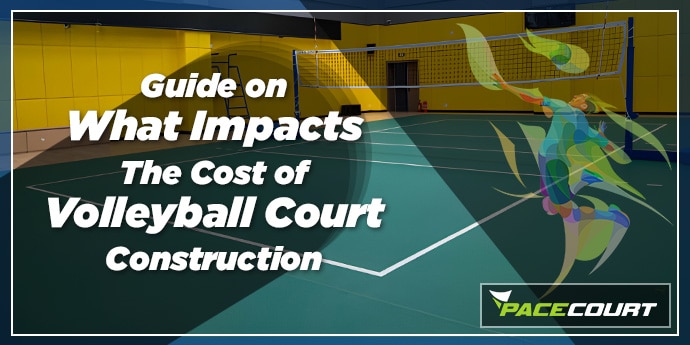Introduction:
Welcome to Pacecourt's complete guide on the factors that determine the cost of Volleyball Court Construction. As a leading manufacturer of synthetic acrylic materials for sports floors, Pacecourt understands the value of creating high-quality and efficient athletic facilities. To make budgets and plans, it is important to know what drives costs when building a volleyball court be it in a school or university compound, community center, or even at any professional sports complex.
And now let’s plunge into this and discover how the cost of volleyball court construction can be maximized. Pacecourt can help you realize your dream of owning a volleyball court.
Factors that Impact the Cost of Volleyball Court Construction:
Here are the key factors that impact the cost of Volleyball Court Construction:
1. Dimension and Court Size:
The total cost is based on the size and the dimensions of the court. In indoor courts, regulation volleyball courts measure 59’ in length and 29.5 feet in width whereas this may differ for outdoor ones. Increasing construction costs include a requirement for more materials and labor.
2. Surface Material
The kind of surface material you choose is a major determinant of the cost of constructing your volleyball court. Depending on the materials used, which include asphalt, concrete, or synthetic acrylic flooring among others, their prices may vary. Synthetic acrylic sports flooring materials are what Pacecourt specializes in since they are durable with good performance ability as well as low maintenance costs associated with them. Although initial investment might be higher when using superior material types, significant savings over time can be made through less repair work because maintenance can go down.
3. Subbase Preparation
Volleyball courts have to be properly prepared at the subbase level if they are to serve for long without collapsing or losing balance. Several aspects including soil type, drainage system requirements, and compaction levels determine how much it will cost to prepare the subbase. An elaborate site preparation is an investment that prevents future problems such as uneven settling or drainage issues which would otherwise result in expensive repairs later on.
4. Add-ons and Facilities
The overall cost of constructing a volleyball court can be greatly influenced by other features and amenities such as lights, fences, nets, and seating spaces among others. The project becomes costly by the same token that these elements make it more functional and attractive. As you plan your budget, think about essential facilities to optimize cost-effectiveness.
5. Working Force Costs
The biggest part of the entire project expense is labor costs which include skilled workers needed for construction, installation, and finishing activities. Labor costs are determined by factors such as wages for employees, a pool of qualified contractors available on site, and the complexity of work involved in the project. Engaging professionals guarantees quality services thereby reducing cases of delays or mistakes that could escalate construction costs.
6. Place and Accessibility to the Site
Volleyball court location as well as accessibility to site equipment as well construction materials will impact construction expenses. Remote or rough places would need extra planning on logistics plus transportation charges leading to higher overall expenditure on projects done. Identifying site conditions and handling logistical obstacles during the initial stages of planning will help reduce these charges but not remove them altogether unless something concrete is done to avoid them completely.
7. Permitting and Regulatory Compliance
The costs of obtaining permits and ensuring compliance with local building codes as well as zoning ordinances are not to be ignored. Such issues as the volume of fees, inspections, and obligation to meet harmful substances criteria can affect the project’s financial plan. To make the licensing process faster and reduce possible delays or costs, a great idea is to work with professionals who know the local rules.

How to Keep Cost Down:
It is important to keep the costs down while building a volleyball court so that you do not exceed your budget and at the same time maintain its quality. Here are some ways on how to spend less:
Plan Carefully:
Have a plan in place before you start construction. Specify the parameters, dimensions of size, and characteristics of the volleyball court to avoid surprise changes or additional expenses in the future.
Optimize Site Preparation:
Settle for an area with few demands regarding grading, drainage, and slash removal to reduce the cost of site preparation. Select level residential land that will need fewer earthworks.
Choose Cost-Effective Materials:
Materials selected must be economical but still serve their purpose well. Find some alternatives to premium items that will still match performance requirements. Pacecourt provides durable synthetic acrylic sports flooring materials.
Standardize Court Size:
Whenever possible use normal court sizes to avoid customizations that can increase expenditure. They minimize wastage of labor and material hence reducing total costs.
Wherever You Can Do It Yourself:
For instance, undertaking certain tasks yourself such as site preparation, minor landscaping, or installing non-structural elements can reduce costs due to labor. However, be careful to ensure that do-it-yourself efforts satisfy safety and quality requirements.
Get More When You Bundle:
Bundle services with one contractor whenever possible to take advantage of bundled pricing and streamline project coordination. This method can assist in reducing overhead costs while minimizing time wastage.
Factor in Life-cycle Costing:
While it is essential to consider initial costs only also think about maintenance and repairs as well as operational expenses on a long-term basis. Thus if you use more durable materials upfront that have efficient design features then it could save money over the life of the volleyball court.
Conclusion:
Building volleyball courts entails different factors that influence general construction expenses. The overall budget depends on the court’s dimensions, surface material used, preparation for sub-base installation, and labor charges among others. By comprehending these aspects and sourcing products from Pacecourt as well as collaborating with reliable constructors, you can have a well-done, Volleyball court regarding your expectations. This implies that when one invests in an excellently built volleyball court whether meant for leisurely use or competitive sports involving lots of people in a residential area it increases value which lasts longer than this brief period.


